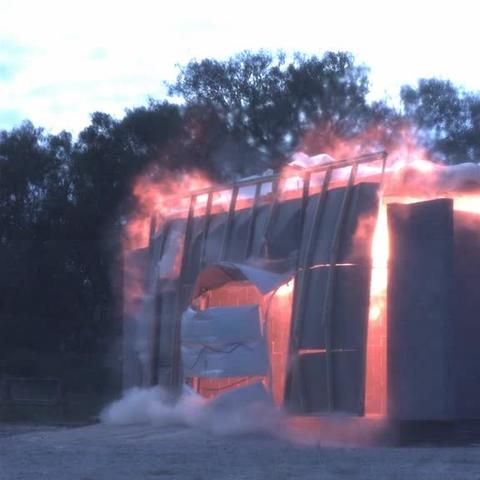Dispersion and Burning Behavior of Hydrogen Released in a Full-Scale Residential Garage in the Presence and Absence of Conventional Automobiles

Nominal hydrogen concentration near ceiling was 28.8 % at ignition.
Supplemental Video Materials
The experiments from which the videos were obtained were conducted at Southwest Research Institute (SwRI), San Antonio, Texas under contract to NIST. [1,2] The experimental series was part of the NIST Hydrogen Fire Safety program. The experiments were conducted using a specially constructed stand-alone garage with the garage door closed. Hydrogen was released through a distribution port located flush with the floor at the center of the garage. Several tests were run in which a conventional automobile (various makes and models) with an empty gasoline tank and all windows and doors closed were parked in the garage centered over the hydrogen release. The hydrogen release scenario assumed a constant leak rate sufficient to release 5 kg (a typical amount for full tanks on current hydrogen-fueled automobiles) in 1 h. When the hydrogen concentration reached a specified value at a specific location near the garage ceiling, ignition of the hydrogen/air mixture was initiated using an 80 J squib charge. The entire period during the burning process was recorded using digital hand-held still cameras with video capability, standard high-definition (HD) video cameras, an infrared (IR) video camera, and a high-speed camera operating at 1 kHz. At various times, cameras were placed inside the test garage (protected by a plastic housing) near the floor in the rear right corner (HD camera), at the side windows of the garage viewing the ignition area or the center region (HD and/or IR), and at outside positions located at various distances and angles from the garage (HD, high-speed, and digital hand-held cameras).
| TEST 1 No vehicle was parked inside the garage in this test, and nominal hydrogen concentration near ceiling was 8 % at ignition. |
|---|
| TEST 2 No vehicle was parked inside the garage in this test, and nominal hydrogen concentration near ceiling was 12 % at ignition. |
|---|
| TEST 3 No vehicle was parked inside the garage in this test, and nominal hydrogen concentration near ceiling was 16 % at ignition. |
|---|
| TEST 4 No vehicle was parked inside the garage in this test, and nominal hydrogen concentration near ceiling was 28.8 % at ignition. |
|---|
| TEST 5 A conventional vehicle was parked inside the garage in this test, and nominal hydrogen concentration near ceiling was 8 % at ignition. |
|---|
| TEST 6 A conventional vehicle was parked inside the garage in this test, and nominal hydrogen concentration near ceiling was 12 % at ignition. |
|---|
| TEST 7 A conventional vehicle was parked inside the garage in this test, and nominal hydrogen concentration near ceiling was 16 % at ignition. |
|---|
| TEST 8 A conventional vehicle was parked inside the garage in this test, and nominal hydrogen concentration near ceiling was 17.7 % at ignition. |
|---|
| TEST 9 No vehicle was parked inside the garage in this test, and nominal hydrogen concentration near ceiling was 8 % at ignition. |
|---|
| TEST 10 No vehicle was parked inside the garage in this test, and nominal hydrogen concentration near ceiling was 12 % at ignition. |
|---|
| TEST 11 No vehicle was parked inside the garage in this test, and nominal hydrogen concentration near ceiling was 12 % at ignition. |
|---|
V
| TEST 12 No vehicle was parked inside the garage in this test, and nominal hydrogen concentration near ceiling was 16 % at ignition. |
|---|
| TEST 13 No vehicle was parked inside the garage in this test, and nominal hydrogen concentration near ceiling was 16 % at ignition. |
|---|
Supporting information:
[1] Pitts WM, Yang JC, Blais M, Joyce A (2012) Dispersion and burning behavior of hydrogen released in a full-scale residential garage in the presence and absence of conventional automobiles. 5Self-assembled structures of amphiphilic ionic block copolymers: theory, self-consistent field modeling and experiment. International Journal of Hydrogen Energy 37:17457-17469. http://dx.doi.org/10.1016/j.ijhydene.2012.03.074
[2] Blais, M, Joyce, A (2010) Hydrogen Release and Combustion Measurements in a Full Scale Garage, National Institute of Standards and Technology Grant/Contractor Report, GCR 10-929 (January 2010) 56 pp.
Contacts
-
(301) 975-6662

